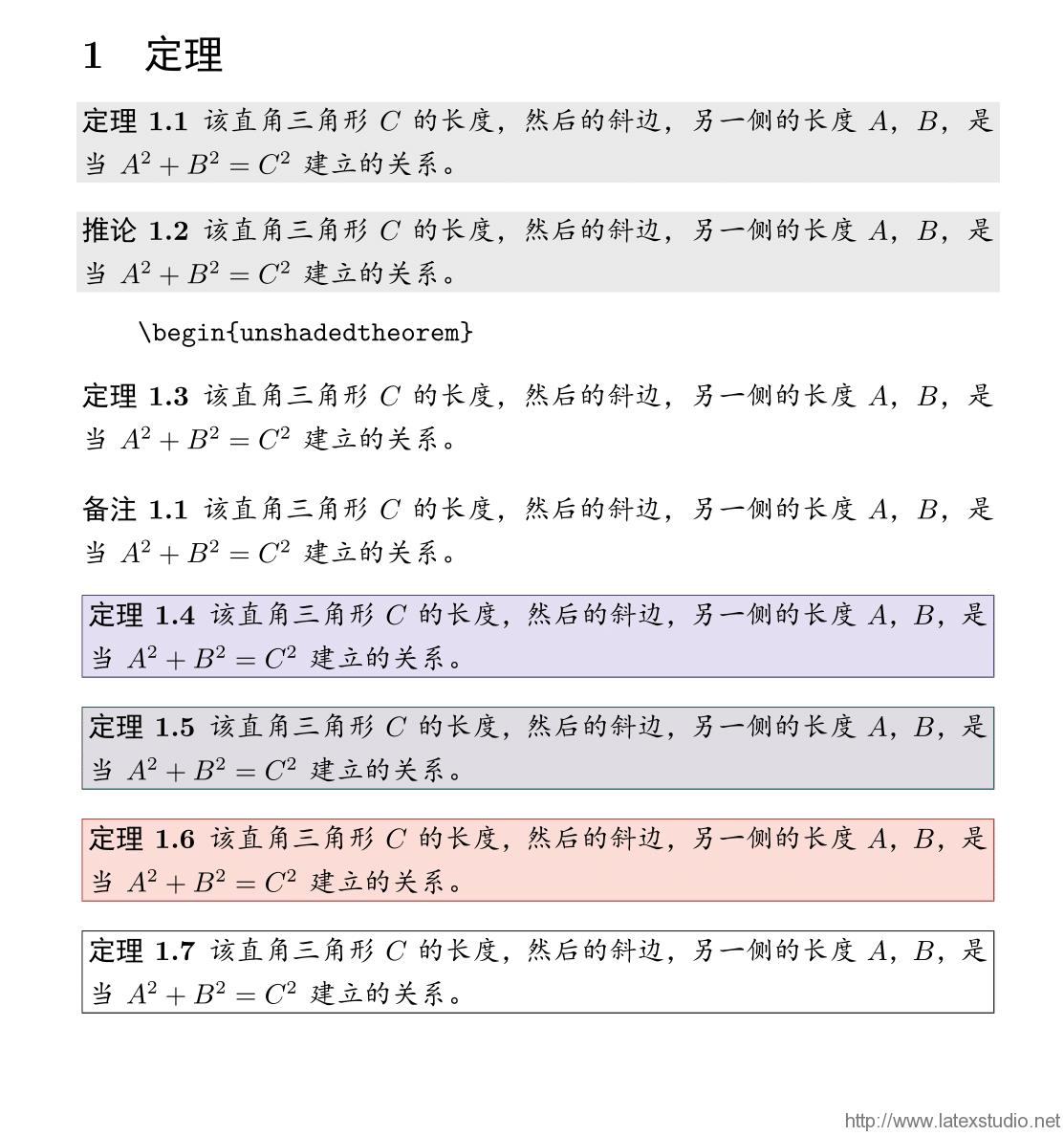\documentclass{article}
\usepackage{ctex}
\usepackage{shadethm}
\newshadetheorem{theorem}{定理}[section]
\newshadetheorem{cor}[theorem]{推论}
\newtheorem{remark}[theorem]{注记}
\newtheorem{unshadedtheorem}[theorem]{定理}
\newtheorem{com}{备注}[section]
\begin{document}
\section{定理}
\begin{theorem}
该直角三角形$ C $的长度,然后的斜边,另一侧的长度$ A $,$ B $,是当$A^ 2+ B^ 2 = C ^2 $建立的关系。
\end{theorem}
\begin{cor}
该直角三角形$ C $的长度,然后的斜边,另一侧的长度$ A $,$ B $,是当$A^ 2+ B^ 2 = C ^2 $建立的关系。
\end{cor}
\verb|\begin{unshadedtheorem}|
\begin{unshadedtheorem}
该直角三角形$ C $的长度,然后的斜边,另一侧的长度$ A $,$ B $,是当$A^ 2+ B^ 2 = C ^2 $建立的关系。
\end{unshadedtheorem}
\begin{com}
该直角三角形$ C $的长度,然后的斜边,另一侧的长度$ A $,$ B $,是当$A^ 2+ B^ 2 = C ^2 $建立的关系。
\end{com}
\setlength{\shadeboxsep}{2pt}
\setlength{\shadeboxrule}{.4pt}
\setlength{\shadedtextwidth}{\textwidth}
\addtolength{\shadedtextwidth}{-2\shadeboxsep}
\addtolength{\shadedtextwidth}{-2\shadeboxrule}
\setlength{\shadeleftshift}{0pt}
\setlength{\shaderightshift}{0pt}
\definecolor{shadethmcolor}{cmyk}{.10,.10,0,0}
\definecolor{shaderulecolor}{cmyk}{.75,.75,0,.5}
\begin{theorem}
该直角三角形$ C $的长度,然后的斜边,另一侧的长度$ A $,$ B $,是当$A^ 2+ B^ 2 = C ^2 $建立的关系。
\end{theorem}
\definecolor{shadethmcolor}{cmyk}{.04,.04,0,.10}
\definecolor{shaderulecolor}{cmyk}{.99,0,0.52,0.70}
\begin{theorem}
该直角三角形$ C $的长度,然后的斜边,另一侧的长度$ A $,$ B $,是当$A^ 2+ B^ 2 = C ^2 $建立的关系。
\end{theorem}
\definecolor{shadethmcolor}{cmyk}{0,.13,.11,0}
\definecolor{shaderulecolor}{cmyk}{0,0.88,0.85,0.35}
\begin{theorem}
该直角三角形$ C $的长度,然后的斜边,另一侧的长度$ A $,$ B $,是当$A^ 2+ B^ 2 = C ^2 $建立的关系。
\end{theorem}
\definecolor{shadethmcolor}{cmyk}{0,0,0,0}
\definecolor{shaderulecolor}{cmyk}{1,1,1,1}
\begin{theorem}
该直角三角形$ C $的长度,然后的斜边,另一侧的长度$ A $,$ B $,是当$A^ 2+ B^ 2 = C ^2 $建立的关系。
\end{theorem}
\end{document}选自:http://www.biwako.shiga-u.ac.jp/sensei/kumazawa/tex/shadethm.html





发表评论 取消回复